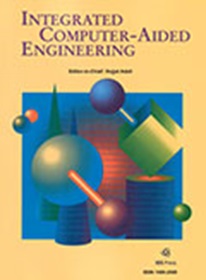在工业丝网印刷中高效检测表面缺陷,最大限度减少贴标工作量
IF 5.3
2区 计算机科学
Q1 COMPUTER SCIENCE, ARTIFICIAL INTELLIGENCE
引用次数: 0
摘要
作为不断发展的工业 4.0 的一部分,基于机器学习的视觉检测在提高生产效率方面发挥着关键作用。丝网印刷是一种多功能、高性价比的制造技术,广泛应用于电子、纺织和汽车等行业。然而,复杂的多层设计在生产过程中很容易出错,从而导致各种外观和类别的缺陷。这些缺陷的特点是相对于大面积样品而言较小且不明显。充分的缺陷可视化和稳健的缺陷检测方法对于应对这些挑战至关重要,特别是考虑到允许的设计可变性。在这项工作中,我们提出了一种新型的自动视觉检测系统,用于检测装饰箔板的表面缺陷。将定制的光学模式集成到顺序检测程序中,可实现与生产相关的缺陷类别的可视化。引入的片状缺陷检测方法旨在利用较少的标记数据,证明可有效用于工业缺陷检测,满足特定的工艺要求。在此背景下,我们提出了一种适用于工业领域且可扩展的数据预处理工作流程,可最大限度地减少整体标记工作量,同时保持高检测性能,这在监督设置中是众所周知的。此外,所提出的方法不依赖于任何标记的缺陷训练数据,在缺陷检测性能和推理速度方面优于最先进的无监督异常检测方法。本文章由计算机程序翻译,如有差异,请以英文原文为准。
Efficient surface defect detection in industrial screen printing with minimized labeling effort
As part of the evolving Industry 4.0 landscape, machine learning-based visual inspection plays a key role in enhancing production efficiency. Screen printing, a versatile and cost-effective manufacturing technique, is widely applied in industries like electronics, textiles, and automotive. However,the production of complex multilayered designs is error-prone, resulting in a variety of defect appearances and classes. These defects can be characterized as small in relation to large sample areas and weakly pronounced. Sufficient defect visualization and robust defect detection methods are essential to address these challenges, especially considering the permitted design variability. In this work, we present a novel automatic visual inspection system for surface defect detection on decorated foil plates. Customized optical modalities, integrated into a sequential inspection procedure, enable defect visualization of production-related defect classes. The introduced patch-wise defect detection methods, designed to leverage less labeled data, prove effective for industrial defect detection, meeting the given process requirements. In this context, we propose an industry-applicable and scalable data preprocessing workflow that minimizes the overall labeling effort while maintaining high detection performance, as known in supervised settings. Moreover, the presented methods, not relying on any labeled defective training data, outperformed a state-of-the-art unsupervised anomaly detection method in terms of defect detection performance and inference speed.
求助全文
通过发布文献求助,成功后即可免费获取论文全文。
去求助
来源期刊

Integrated Computer-Aided Engineering
工程技术-工程:综合
CiteScore
9.90
自引率
21.50%
发文量
21
审稿时长
>12 weeks
期刊介绍:
Integrated Computer-Aided Engineering (ICAE) was founded in 1993. "Based on the premise that interdisciplinary thinking and synergistic collaboration of disciplines can solve complex problems, open new frontiers, and lead to true innovations and breakthroughs, the cornerstone of industrial competitiveness and advancement of the society" as noted in the inaugural issue of the journal.
The focus of ICAE is the integration of leading edge and emerging computer and information technologies for innovative solution of engineering problems. The journal fosters interdisciplinary research and presents a unique forum for innovative computer-aided engineering. It also publishes novel industrial applications of CAE, thus helping to bring new computational paradigms from research labs and classrooms to reality. Areas covered by the journal include (but are not limited to) artificial intelligence, advanced signal processing, biologically inspired computing, cognitive modeling, concurrent engineering, database management, distributed computing, evolutionary computing, fuzzy logic, genetic algorithms, geometric modeling, intelligent and adaptive systems, internet-based technologies, knowledge discovery and engineering, machine learning, mechatronics, mobile computing, multimedia technologies, networking, neural network computing, object-oriented systems, optimization and search, parallel processing, robotics virtual reality, and visualization techniques.
 求助内容:
求助内容: 应助结果提醒方式:
应助结果提醒方式:


